 Aaron Gold
.
July 25, 2023
.
Department
Aaron Gold
.
July 25, 2023
.
Department
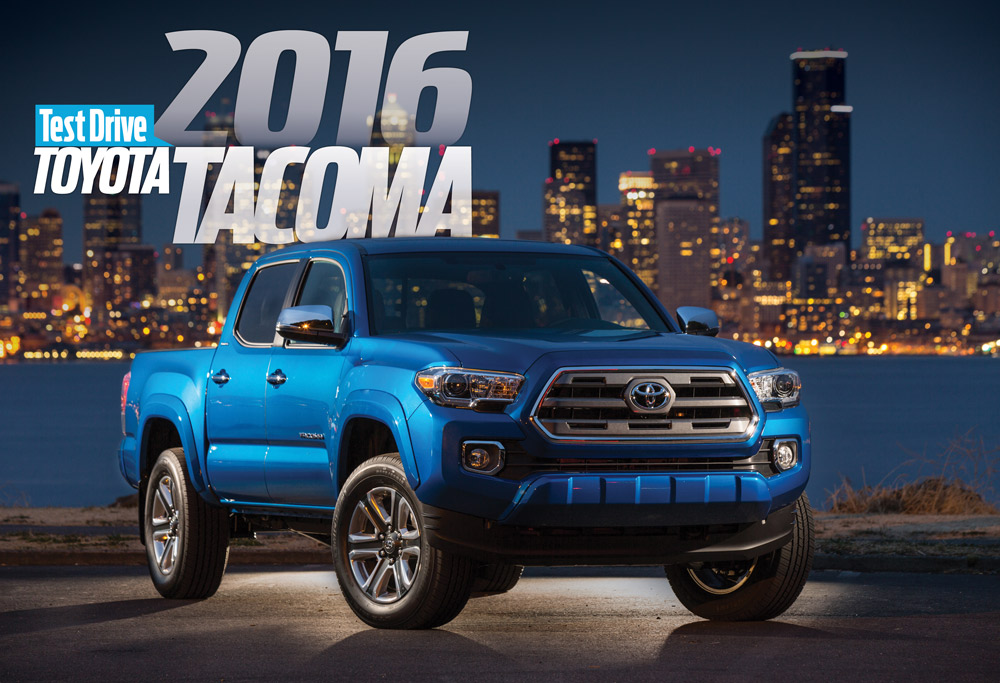
TOYOTA DOESN’T LEAD THE COMPACT PICKUP MARKET IN THE UNITED STATES SO MUCH AS THEY OWN IT. The Tacoma is responsible for just over 50% of small pickup sales, and owner loyalty is so high that most of their competitors have dropped out of the market; even mighty Ford, which builds the best-selling full-size pickups on the planet. What competition there is doesn’t bother Toyota; they say that when GM’s ’15 Chevrolet Colorado and GMC Canyon hit the market last year, the Tacoma saw a 20% increase in sales, and this despite being a 10-year-old design.
So it’s no surprise that with the all-new 2016 Tacoma, Toyota has decided to stay the course. In fact, we hesitate to call the new truck “all new.” Toyota stuck very close to the plan: the frame is an extensively reworked version of the old one, with high-strength steel to increase rigidity. All of the cab’s sheet metal is new (including the floor pan), but when asked directly if a 2015 windshield would fit a 2016 Tacoma, an engineer said, “Probably, but I can’t guarantee it wouldn’t leak.”
The biggest change to the new Tacoma may well be a shift in focus. Toyota says Tacoma owners are adventurers, outdoorsy sorts who want a truck with off-road chops or at least offroad looks. (If you’re a Tacoma owner who disagrees, well, we’re sorry, but this is what the marketing folks have decided, and marketing knows best.) So, the 2016 Tacoma has been altered accordingly. For example, the previous iteration of the Tacoma used a separate frame for 4×2 and 4×4 models, with 4x2s sitting closer to the ground. For 2016, all Tacomas get the 4×4 frame, so even the entry-level $26,285 SR 4×2 has the same stance and 9.4 inches of ground clearance as the beefiest 4×4 model.
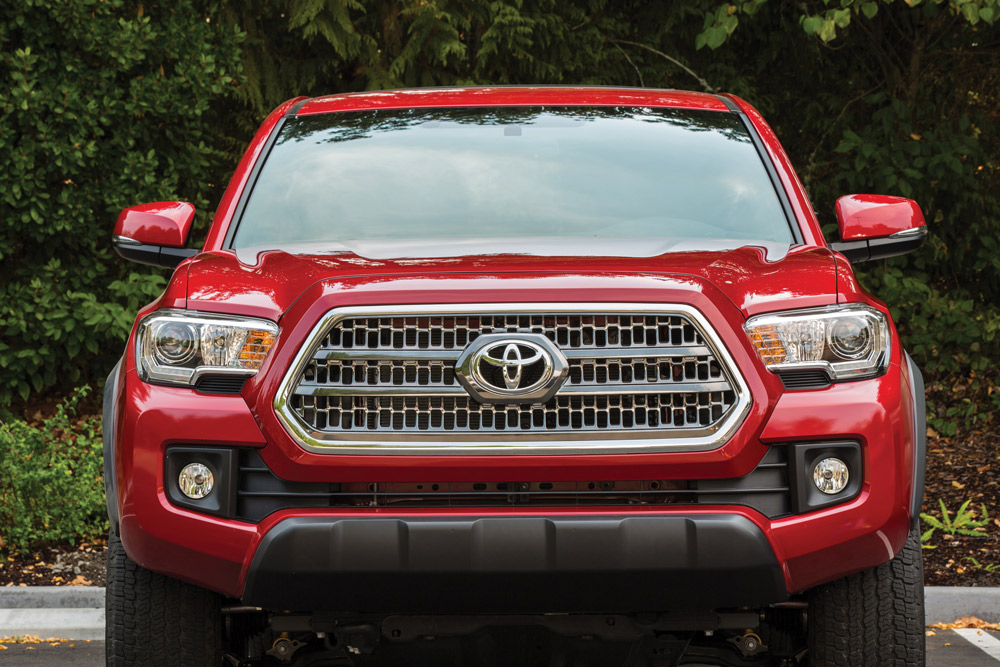
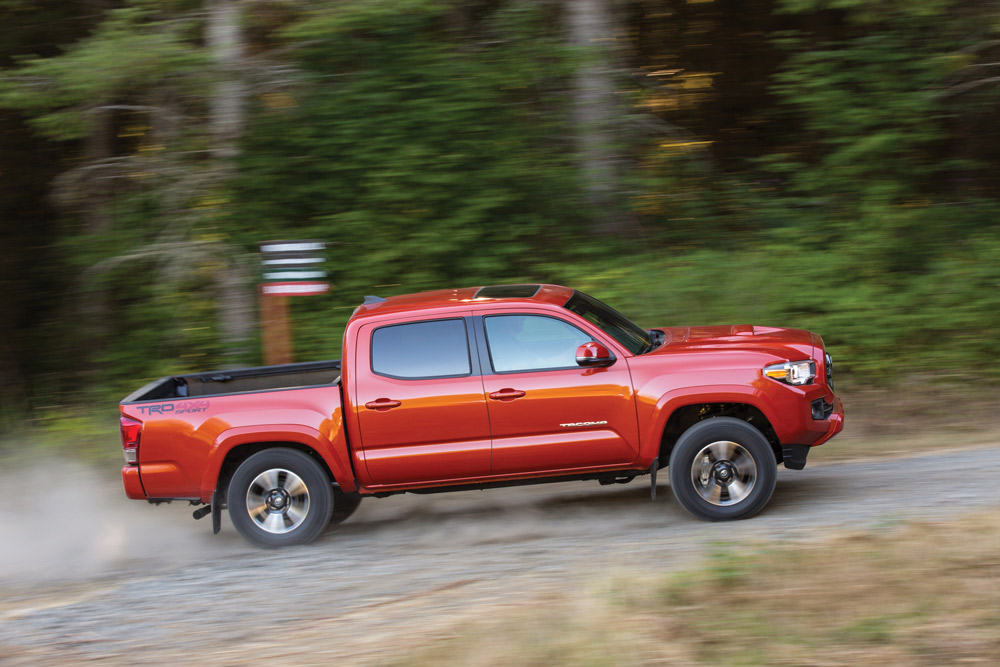
One noticeable change is the face: The trapezoidal grille gives the Tacoma the look of a baby Tundra, though considering the two trucks’ sales records in their respective segments, chances are the goal is to make the Tundra look like a grown-up Tacoma. Crawl around the Tacoma and you’ll find lots of aerodynamic tricks, like a strip between the cab and bed and plastic spats that direct airflow around the wheels and underbody components. In today’s new truck market, anything that’ll net a tenth of an mpg is fair game.
But the biggest change in regard to fuel economy is under the hood. Say so long to the old 4L V-6; it’s been replaced by a version of Toyota’s venerable 3.5. This engine uses Toyota’s variable valve timing system to allow it to run on either a traditional Otto cycle or a fuel-saving Atkinson cycle. During Atkinson operation, the intake valve stays open partway into the compression stroke, allowing some of the fuel-air charge to be blown back into the intake manifold. This effectively shortens the intake stroke, but more importantly, it makes the power stroke longer than the intake stroke, allowing more time for combustion and more energy to be extracted from the fuel-air charge. The change between cycles is seamless, and the new V-6 does indeed return 1-2 mpg more in the EPA fuel economy estimates (5-10% increase) than the old 4L.
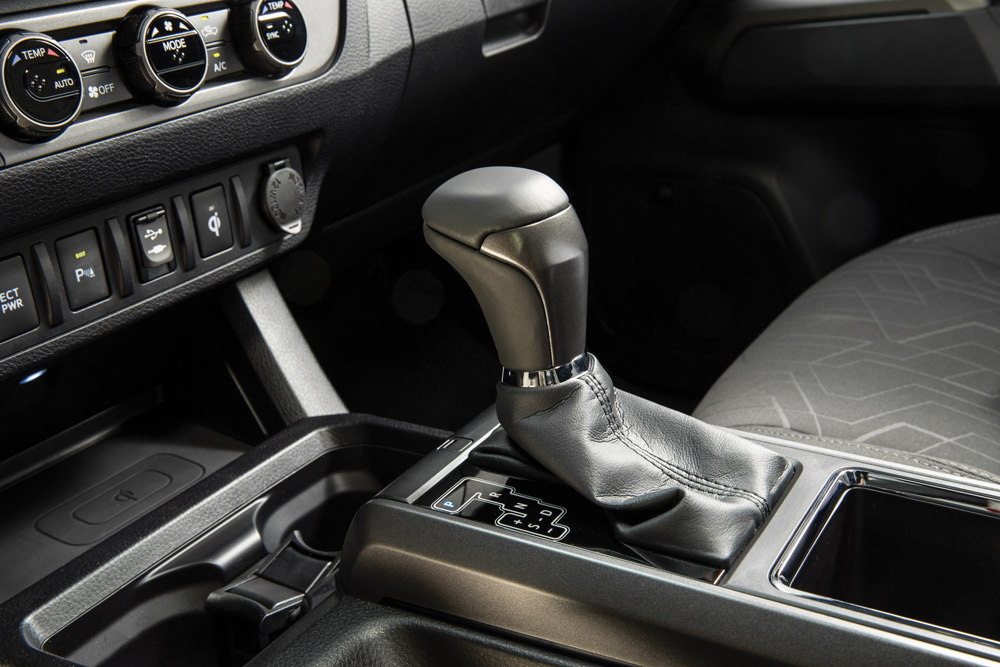
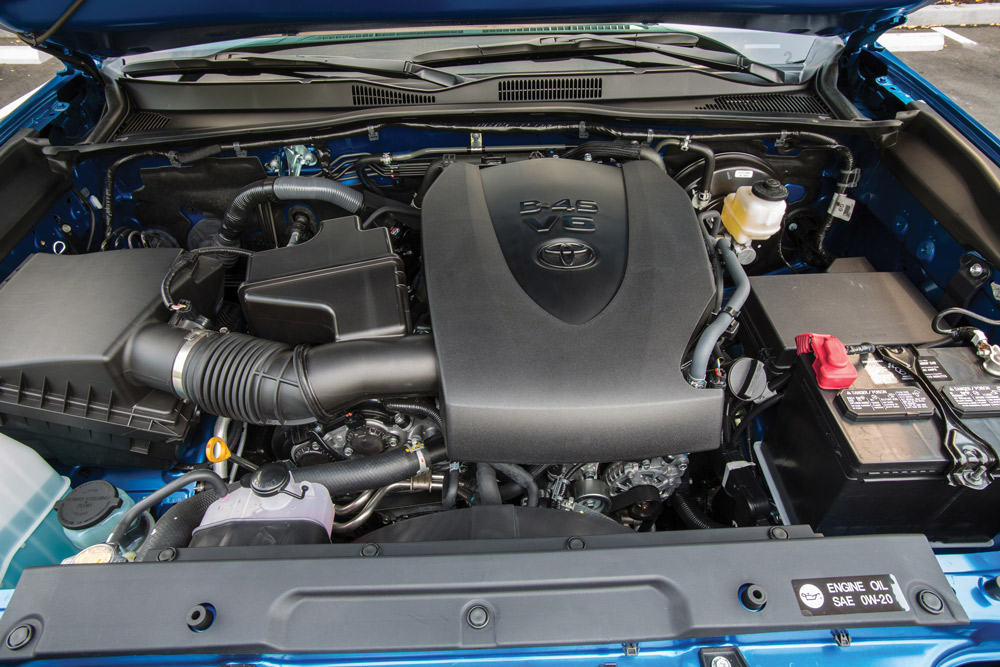
If that wasn’t enough, the new engine also uses Toyota’s D4-S fuel injection system, which combines both indirect and direct fuel injection. Each cylinder has a pair of injectors, one in the intake manifold and one in the cylinder. The ECU uses either or both depending on engine speed and temperature.
For those counting numbers, the new engine develops 278 hp and 265 lb-ft of torque, a 42-hp increase (and a 1-lb-ft decrease) compared to the old V-6. It can be had with either a six-speed manual or a six-speed auto, though a manual is only offered on four-wheel-drive models.
For those who don’t like change, you’ll be pleased to know that the 159 hp/259 lb-ft 2.7L four is basically unchanged. Transmission choices are the same as for the V-6, except that the fourbanger’s stick-shift gets only five speeds.
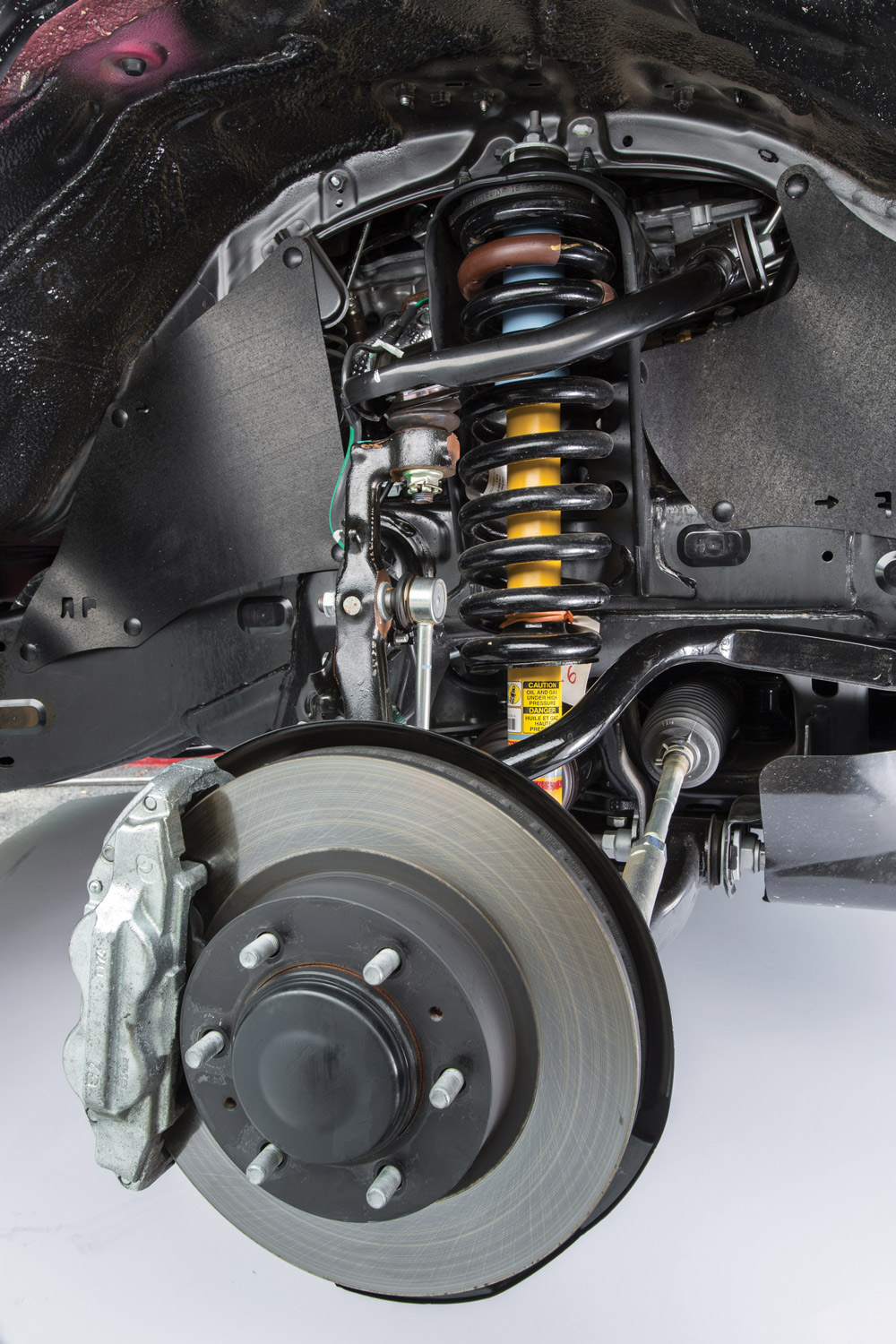
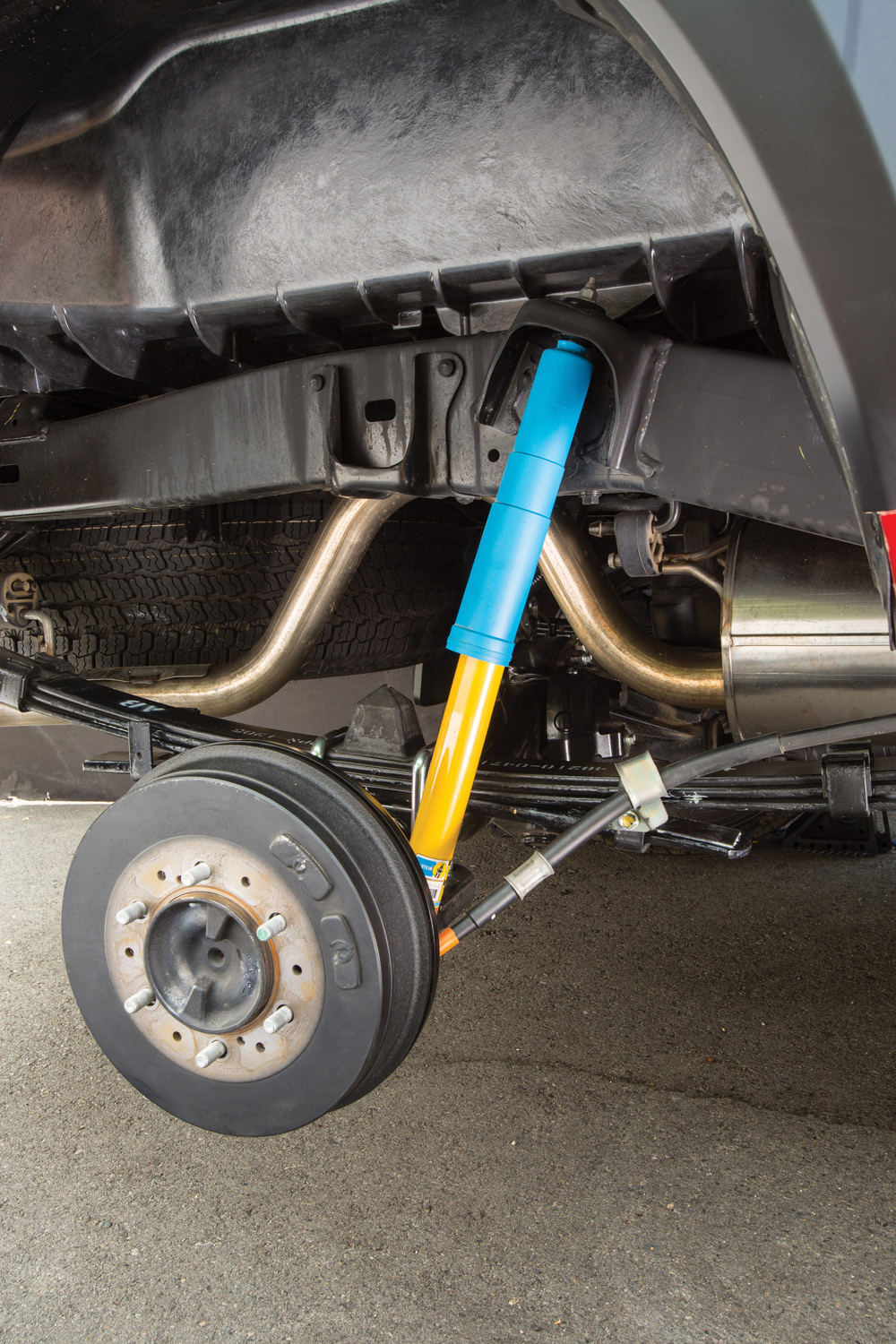
DETAILS AND SPECS
2016 TOYOTA TACOMA
Inside, the Tacoma follows Toyota’s new interior design mantra, which seems to be that different is better. Though we’re not a fan of everything Toyota does, we have to admire the layout of the new Tacoma’s dash. A 6.1-inch touch-screen stereo (standard across the board, though higher trim levels get more features) is flanked by large AC vents with rotary-dial air conditioning controls underneath and auxiliary switches underneath that. The old three-dial gauge pod has been replaced by a two-dial unit with an electronic display in the center. The seats are divided by a wide center console with a softly padded armrest covering a large storage box, and next to the shifter is— surprise, surprise—a proper hand brake.
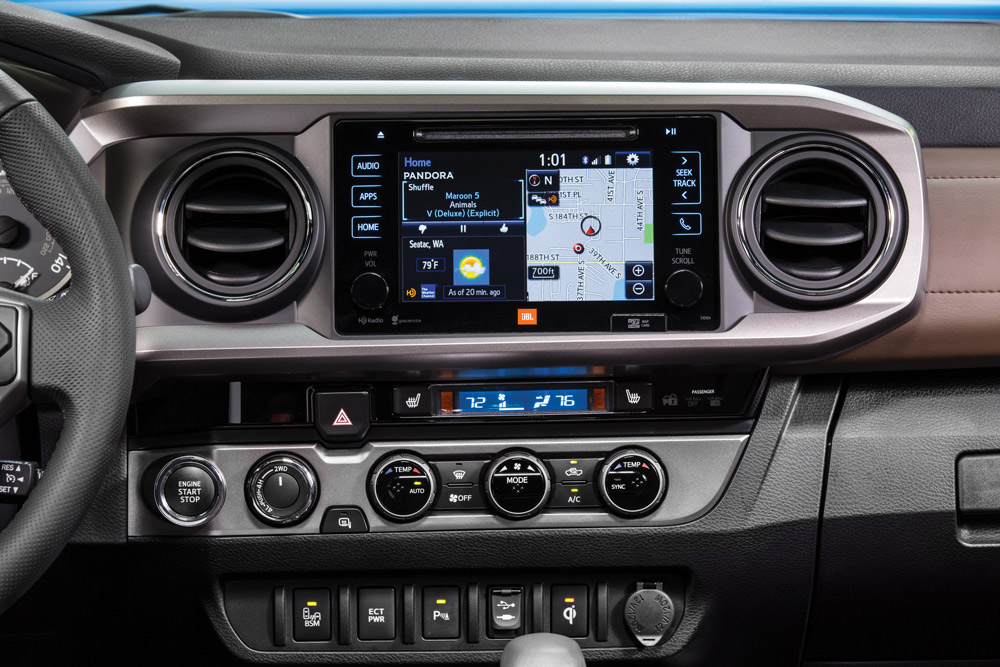
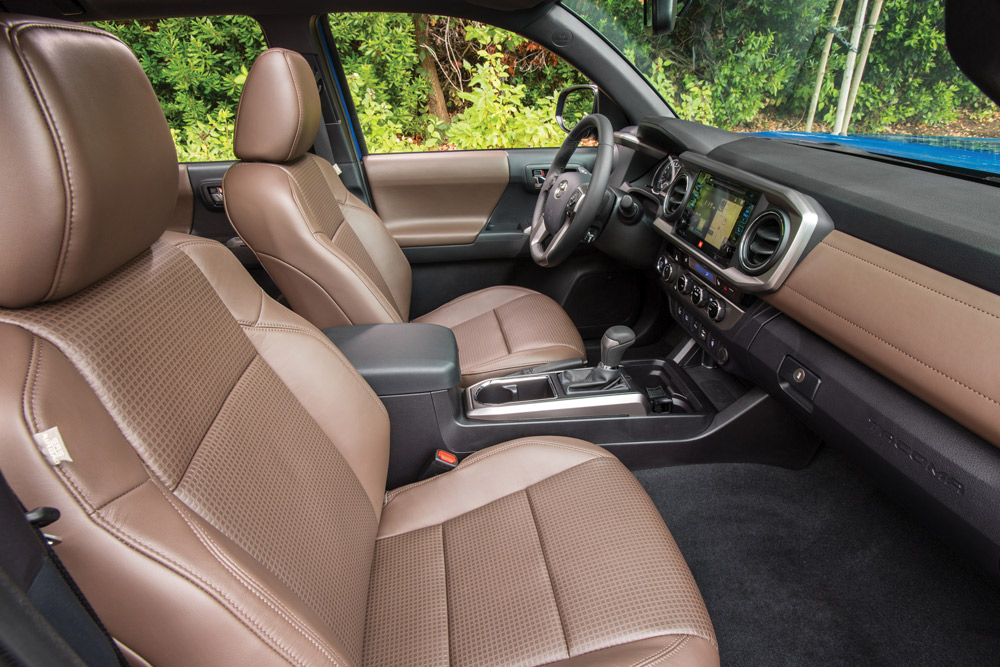
The stripped-down “gardener’s truck” has been slowly disappearing from the Tacoma lineup. As with the outgoing model, niceto- haves like power windows, mirrors and locks and air conditioning are standard, with the addition of a touch-screen stereo. Regular cabs are gone; all Tacomas now come with either extended (Access) or crew (Double) cabs, the latter available in long or short wheelbase with a 5- or 6-foot bed. (Access cabs come in a single wheelbase with the 6-foot bed.) A bed liner is standard, as is a lockable and removable tailgate with damped hinges (it opens slowly instead of slamming down).
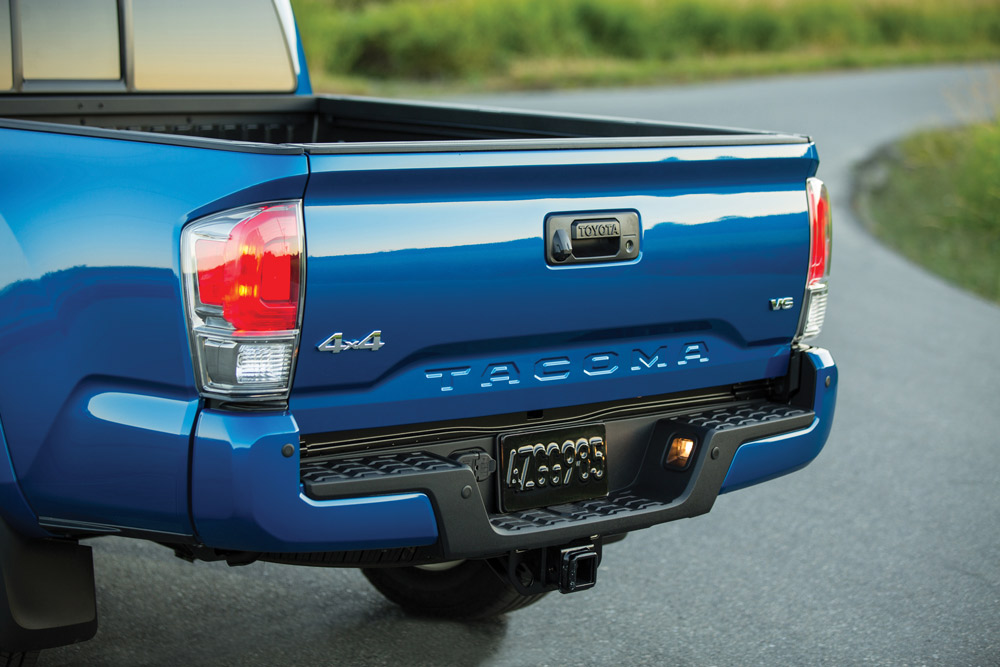
Toyota does offer a utility package on the base model SR Access Cab, which deletes the back seat and its associated hardware, eliminates the sliding rear window and replaces the body-color bumpers, door handles and mirror caps with black plastic. At the opposite end of the spectrum is the $34,745 Tacoma Limited, with heated leather seats, dual-zone automatic climate control, a sunroof and a high-end JBL stereo with integrated navigation and a subwoofer. Most of these features (except leather) are offered on the interim SR5, TRD Sport and TRD Off-Road grades.
The TRD (Toyota Racing Development) are the off-roadthemed models (though, strangely, both are available in both 4×2 and 4×4 versions). The TRD Sport gets a rugged interior theme and a hood scoop, but if you’re as serious about your offroading as the Toyota marketing folks want to believe you are, it’s the TRD Off-Road model you’ll want. Trim is similar to the TRD Sport (minus the hood scoop, which is too bad), but the TRD Off-Road gets unique suspension tuning and (when equipped with an automatic trans) a multi-terrain selection system with settings for loose rock, mud and sand and Crawl Control.
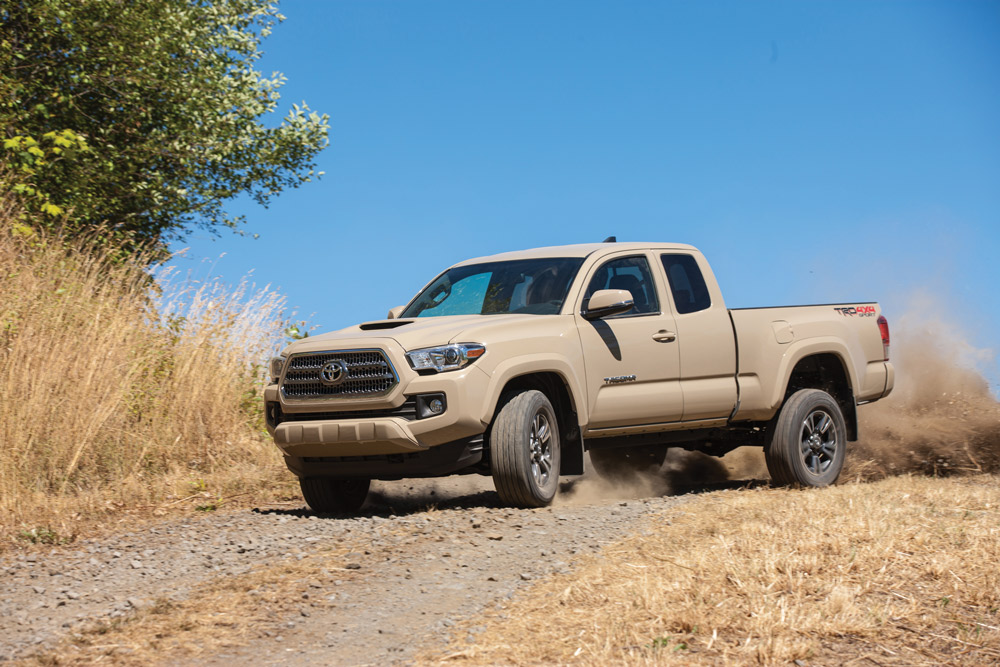
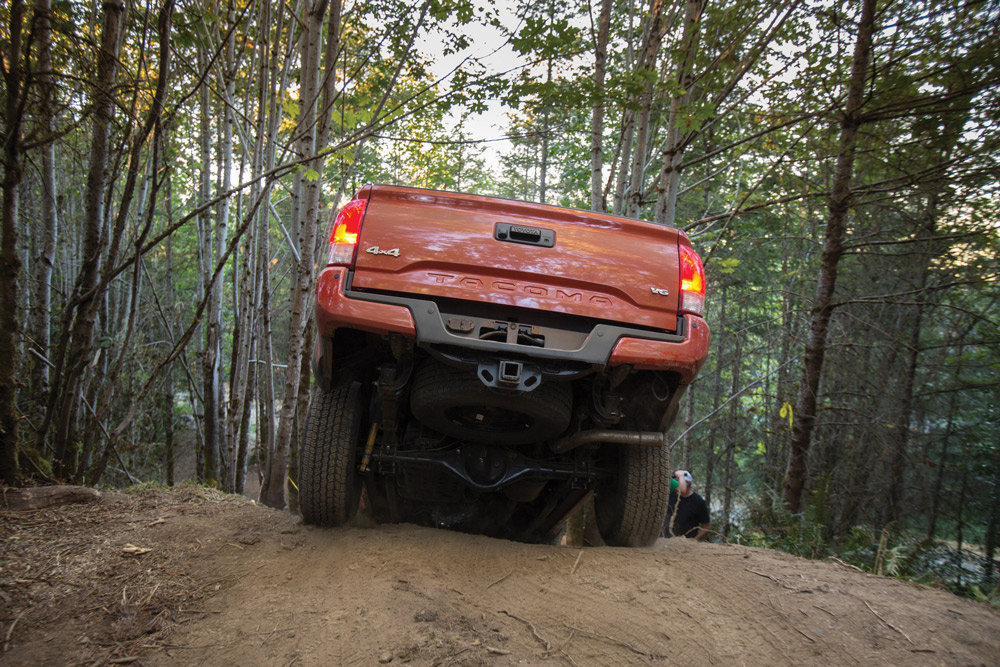
The Crawl Control system first appeared on the Land Cruiser and 4Runner. If you’ve done any offroading, you’re probably familiar with hill descent control, which controls the brakes on individual wheels for a steady, sure-footed descent over steep, rough terrain. Crawl Control does the same thing, but it works uphill and down, controlling both power and brakes to maintain a pre-set speed selected by a dial on the headliner. Yeah, yeah, we know—this is Street Trucks, not Off-Road Trucks, but we can’t help but be impressed with how well Crawl Control works. If you’re not an experienced offroader, this system can get you out of some rather sticky situations with minimal risk to both your wheels and your well being.
All in all, we think Toyota has done the right thing by keeping the Tacoma on the same course. This is, after all, America’s favorite compact pickup truck. Why change it?
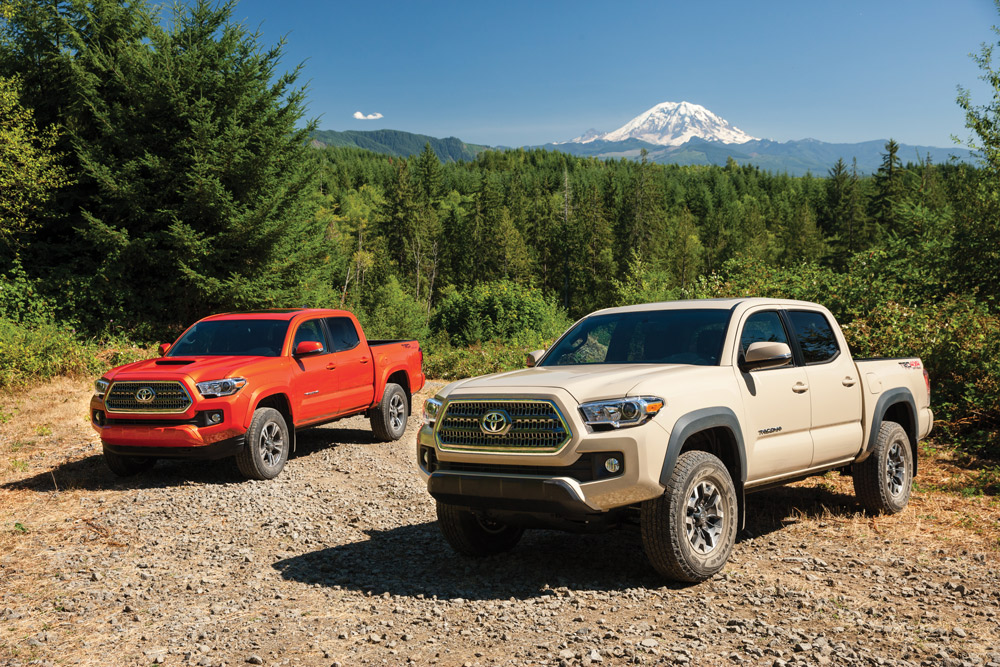
The Tacoma’s newfound off-road ability may be of limited utility to Street Trucks readers, though the added wheel travel of the off-road-biased setup may prove to be beneficial for those wishing to get their trucks closer to the ground rather than further away from it. The fancy (and well integrated) electronics may make matters more complicated for those who want to extensively rewire, but such is the march of progress.
At the end of the day, the new Tacoma is just another Toyota pickup: small, strong and bulletproof. And that, friends and neighbors, is why they own the small pickup market.
So how does the new Tacoma drive? Remember, Toyota wasn’t looking to change much, and we found that the driving experience closely paralleled the outgoing Tacoma. Our test drive was limited to V-6-powered 4×4 automatics, with most of our seat time in the blue Limited truck seen in our photos. Though the goal of many automakers is to make their big vehicles feel like small ones, the Tacoma still feels like a proper truck, and we like that. With similar torque ratings, the new V-6 pulls like the old one; all the fuelinjection and cycle switching magic is transparent to the driver. We’re especially glad that Toyota kept the dimensions the same; as before, the Tacoma is big enough to be a useful hauler and small enough to be manageable in daily driving.
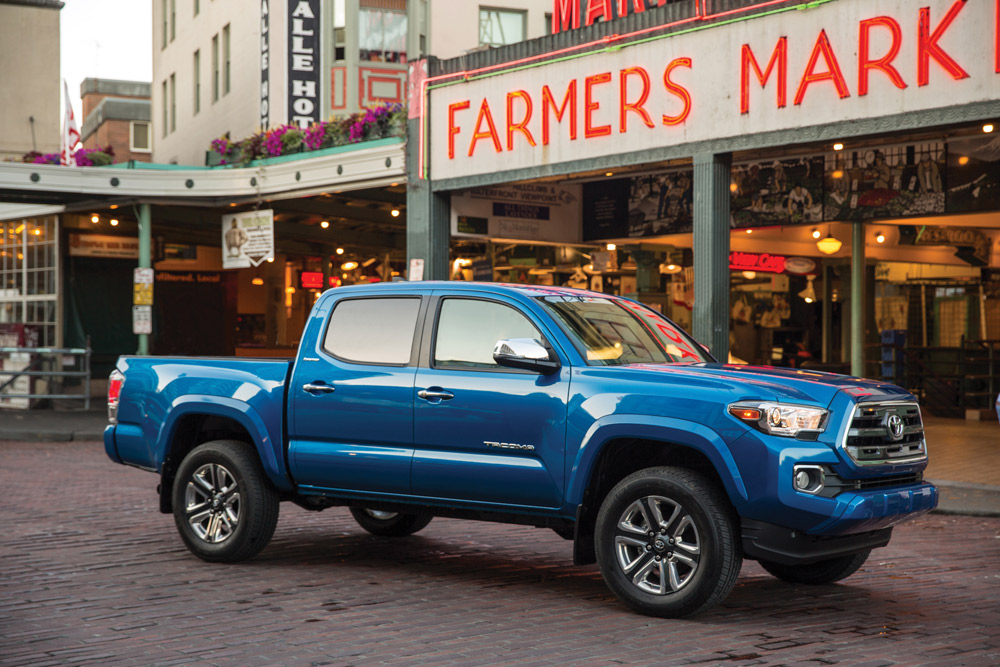
Toyota wanted us to experience the Tacoma’s off-road chops, and they really are impressive. We’ve experienced Crawl Control in other Toyota models and are familiar with the system’s advantages as well as its limitation (it tends to buck like a donkey when set to the lower speeds). Offroading on auto-pilot is an unusual experience no matter how many times you do it, but the system really does work, and it works well. We also tackled some of the same terrain in a Tacoma without the fancy off-road electronics, and that was a good reminder that the Tacoma has all the basics: plenty of ground clearance, good grip and an effective crawl ratio.
Share Link